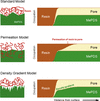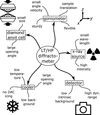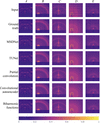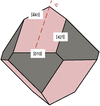issue contents
October 2022 issue

Cover illustration: Colombo et al. [J. Appl. Cryst. (2022), 55, 1232–1246] introduce a fast method for wide-angle coherent scattering simulations of weakly absorbing isolated samples, called the Scatman. Its quantitative agreement with exact solutions and the low simulation time of its software implementation PyScatman open new perspectives for single-shot 3D coherent diffraction imaging.
research papers
Open  access
access
 access
accessThe concept of a radially symmetric spin echo small-angle neutron scattering (SESANS) setup is introduced and analyzed.
Open  access
access
 access
accessA method is developed to determine multiple simultaneously illuminated crystallographic orientations producing superimposed Laue diffraction patterns on a single detector image, using only spot positions. Tests performed on simulated data show the capability of indexing at least 100 crystals, even if fake spots are added, true spots are removed and noise is added. Further validation on synchrotron microdiffraction data is also provided.
Open  access
access
 access
accessA program for the digitization of Guinier powder diffraction images is described, which works with images from both optical and laser scanners. Thus, processing of data from storage-phosphor-based imaging plates and Ag-based photographic films is possible.
A new Laue microdiffraction microscopy technique is introduced based on coded apertures for rapidly imaging the 3D microstructure of crystalline materials.
Rocking curve imaging using a double-crystal configuration with perfect protein crystals is demonstrated.
Open  access
access
 access
accessAn indirect Fourier transform method is presented which describes a solution scattering profile from a reduced set of intensities. Equations are derived to fit the experimental profile using least squares and to calculate commonly used size and shape parameters directly from the reduced set of intensities, along with associated uncertainties. An analytical equation is derived enabling regularization of the real-space pair distribution function. Convenient software is provided to perform all described calculations.
Open  access
access
 access
accessA full-field X-ray diffraction contrast method is presented (high-resolution 3D X-ray diffraction), for 3D mapping of plastically deformed microstructures. The essence of the method is the introduction of a 2D detector in the optical mid-field regime. The properties and limitations of the method are estimated by numerical simulations.
Open  access
access
 access
accessX-ray diffraction imaging contrast from individual silicon n–p–n bipolar transistors within fully encapsulated packages under conditions of extremely high forward bias is interpreted as arising from the effects of current crowding in the emitter region.
Spin-contrast-variation neutron reflectivity can be used to obtain multiple reflectivity curves from a single sample and a single beam source. This advantage of the technique allowed a structural analysis of the interface in a bilayer film comprising layers of acrylic urethane resin and methylated-perhydropolysilazane-derived silica (MePDS). It is revealed that, although the MePDS layer has a higher porosity near the interface with the resin, the resin did not permeate the pore network.
Open  access
access
 access
accessThe contributions of grain facet reflectivity and scattering from the bulk of a grain of highly absorbing material were calculated as a function of sample characteristics. To test these results, the scattering intensity of a grain of microporous ThO2 was experimentally characterized by small-angle X-ray scattering using a synchrotron source. In addition, a new experimental method to probe the porous texture of nanoporous powders of highly absorbing compounds using a laboratory X-ray instrument has been proposed.
Download citation


Download citation


Open  access
access
 access
accessThe nuclear and magnetic structures of Mn3Fe2Si3 are determined and the magnetic properties are compared with those of the parent compound Mn5Si3. The results imply that the distinct magnetic sites play an important role in the magnetocaloric behaviour of the family.
The application of neutron scattering to the study of metallic reentrant spin glasses is reviewed through a series of experimental results. In particular, the role of small-angle neutron scattering is highlighted. A few lines of work which could be pursued thanks to recent developments of the technique are suggested.
Open  access
access
 access
accessA novel and accurate method to align crystalline samples for Bragg coherent X-ray diffraction imaging using electron backscatter diffraction is presented. An efficient approach using the complex exponential of the phase to calculate the strain is also implemented, for greater accuracy in resolving crystal defects.
A linear dependence of reflectivity spectra on the resonant absorption coefficient is obtained in the total external reflection region, but only for ideal cases of low-absorptive homogeneous resonant media or ultrathin resonant layers. Restrictions for simplified treatment of the reflectivity spectra as absorption spectra are revealed by theoretical analysis and model calculations.
Results of mechanical stretching/shrinkage in a perfect Si 400 single crystal are studied in order to use it as an angular static d-spacing tunable monochromator in the Bragg case.
A miniature airlock system to aid the cryo-cooling of protein crystals grown under anoxic conditions
In a glovebox, flash-cooling of oxygen-sensitive or oxygen-dependent protein crystals under anoxic conditions is challenging. To make this operation manageable, a new miniature airlock system was designed to facilitate the transfer, flash-cooling and retrieval of crystals from a glovebox into an external liquid nitrogen container.
Open  access
access
 access
accessIn the frustrated chiral magnet Co6.75Zn6.75Mn6.5, small-angle neutron scattering reveals that the mesoscale chiral magnetism displays strong disorder and the skyrmion phase is nearly entirely suppressed.
Open  access
access
 access
accessA fast method for wide-angle coherent scattering simulations of weakly absorbing isolated samples, called the Scatman, is presented. Its quantitative agreement with exact solutions and the low simulation time of its software implementation PyScatman open new perspectives for single-shot 3D coherent diffraction imaging.
This article describes the computation of the phase transformations between aspirin forms I and II that would be caused by application of various temperatures and pressures.
Download citation


Download citation


Open  access
access
 access
accessThe design and operation of a newly commissioned single-crystal X-ray diffractometer (HTD2) are presented. The device enables experiments under simultaneous low-temperature and high-pressure conditions using a laboratory X-ray source.
Download citation


Download citation


The formation is reported of a new polymorph of atovaquone as the product of sublimation and evaporation of Form I. This is the first report on the sublimating behaviour and potential glass transition temperature of atovaquone.
CCDC reference: 2094320
Open  access
access
 access
accessA number of machine-learning-based algorithms are presented for the reconstruction of gaps in experimental X-ray scattering images through inpainting approaches.
Open  access
access
 access
accessA detailed description of 2D and 3D epitaxies of the main {010}, {001} and {100} forms of deposited bassanite (CaSO4·0.5H2O) on {10.4} calcite (CaCO3) is reported.
Open  access
access
 access
accessThe newly defined and rotationally invariant 2D integral breadth correctly measures plastification-induced peak broadening during micro-Laue diffraction experiments, and allows for both critical thickness and plastic onset measurements. Applied to the quasi-lattice-matched HgCdTe/CdZnTe heterostructure and taking into account the critical thickness only, it showed that the plastic onset of the rigid substrate perfectly matches the elastic limit of the smooth layer: a striking demonstration of the propagation of threading dislocations.
Open  access
access
 access
accessAn analysis approach for co-refinement of X-ray reflectivity measurement is presented, which works with sparsely sampled or noisy data for seven- to 200-fold speed increases.
Open  access
access
 access
accessA method is presented for extracting quantitative information on superconducting vortex lattices and other mesoscopic structures from time-of-flight small-angle neutron scattering.
Promising new structures of transition metal dichalcogenides have been discovered theoretically. The low values of enthalpy suggest the possibility of experimental synthesis.
Open  access
access
 access
accessCombined neutron and X-ray powder diffraction investigations of CoFe2O4 are reported, aimed at investigating the robustness, reproducibility and reliability of structural parameters from Rietveld refinement.
teaching and education
Open  access
access
 access
accessAcross the sciences, generic monitors of trust in results from science are being introduced. As educators and researchers, the authors consider these terms within the context of biological and chemical crystal structure analyses.
Open  access
access
 access
accessTo aid understanding of the idea of the ionic radius, a statistical analysis of the bond-length distributions for real crystal structures in the Crystallography Open Database is presented. A package to reproduce the results is freely available from https://github.com/tkotani/CEBond.
Open  access
access
 access
accessThe authors share experience of teaching an interdisciplinary university course in crystal growth with examples ranging from geology to biology.
computer programs
Introduced here is the open-source software package diffpy.mpdf for magnetic pair distribution function analysis. Written in Python and part of the DiffPy suite for diffraction and pair distribution function analysis, this package allows users to build magnetic structures, calculate one- and three-dimensional magnetic pair distribution function patterns, and perform fits to magnetic pair distribution function data.
Open  access
access
 access
accessThis paper presents the Domain Auto Finder (DAFi) program and its application to the analysis of single-crystal X-ray diffraction (SC-XRD) data from multiphase mixtures of microcrystalline solids and powders. The DAFi algorithm is designed to quickly find subsets of reflections from individual domains in a whole set of SC-XRD data and neither requires a priori crystallographic information nor is limited by the number of phases or individual domains.

 journal menu
journal menu





















































